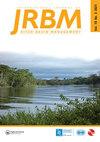巴西东南部两个水管理单元的基流和水恢复力变异性
IF 1.9
Q3 WATER RESOURCES
International Journal of River Basin Management
Pub Date : 2021-11-09
DOI:10.1080/15715124.2021.2002346
引用次数: 3
摘要
人口稠密地区的气候和水需求变化日益影响水文系统,进而影响社会经济条件。在本案例研究中,我们确定了巴西圣保罗州(Sao Paulo state)的两个水资源管理单元Tietê-Jacaré (TJ)和Piracicaba-Capivari-Jundiaí (PCJ)的水文地质框架如何在面对人为活动和气候变化引起的流量波动时控制基流过程和恢复力。结果表明,在结晶和沉积含水层上覆的盆地中,基流对总流量的贡献在40%到75%之间。PCJ盆地大部分为过结晶含水层,水停留时间较短,对地表水的依赖性较大。因此,干旱期PCJ流域的水流是脆弱的,管理模式影响了流域的水恢复力(向Cantareira系统调水)。由于具有重要的沉积含水层,TJ流域的含水层流量贡献更大,在降雨模式变化的条件下,该流域的恢复能力增强,呈现出更稳定的恢复态势。最终,这两个管理单位需要不同的规划策略和适应性和动态行动,以减轻由水资源的变化和减少引起的社会、经济和环境影响。水文地质框架在基流中的作用评价及其对流域水安全的影响。水资源管理面临着激烈的人类学行动和降雨行为变化的挑战,以大都市地区的热带盆地为例。本文章由计算机程序翻译,如有差异,请以英文原文为准。
Baseflow and water resilience variability in two water management units in southeastern Brazil
ABSTRACT Changes in climate and water demand in densely populated regions increasingly affect hydrological systems, and, in turn, impact socioeconomic conditions. In this case study, we identify how the hydrogeological frameworks of two water resource management units, Tietê-Jacaré (TJ) and Piracicaba-Capivari-Jundiaí (PCJ) in Sao Paulo state (Brazil), control the baseflow processes and resilience in the face of streamflow fluctuations in response to anthropogenic activities and climate variation. The results reveal between 40% and 75% contributions of baseflow to total streamflow in basins overlying crystalline and sedimentary aquifers. The basins in PCJ which mostly overly crystalline aquifers, have shorter water residence times and greater dependence on surface water. Therefore, streamflow in the PCJ basins is vulnerable during the drought period and the management model affected the water resilience of the basins (transfer of water to Cantareira System). The TJ basins have greater streamflow contributions from aquifer discharge linked to the presence of important sedimentary aquifers, which improves resilience under changing rainfall patterns, these basins present a more stable situation of resilience. Ultimately, the two management units require different planning strategies with adaptive and dynamic actions to mitigate the social, economic, and environmental effects caused by the variability and reduction of water sources. Key points Assessment of the role hydrogeological framework in the baseflow and its impact on basin water security. Water management challenges faced to intense anthropological actions and changes in rainfall behaviour, case of tropical basins in metropolitan regions.
求助全文
通过发布文献求助,成功后即可免费获取论文全文。
去求助
来源期刊

International Journal of River Basin Management
WATER RESOURCES-
CiteScore
6.00
自引率
4.00%
发文量
48
期刊介绍:
include, but are not limited to new developments or applications in the following areas: AREAS OF INTEREST - integrated water resources management - watershed land use planning and management - spatial planning and management of floodplains - flood forecasting and flood risk management - drought forecasting and drought management - floodplain, river and estuarine restoration - climate change impact prediction and planning of remedial measures - management of mountain rivers - water quality management including non point source pollution - operation strategies for engineered river systems - maintenance strategies for river systems and for structures - project-affected-people and stakeholder participation - conservation of natural and cultural heritage
 求助内容:
求助内容: 应助结果提醒方式:
应助结果提醒方式:


